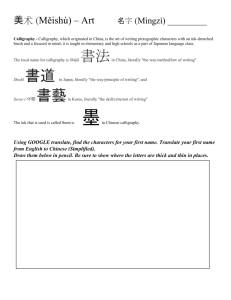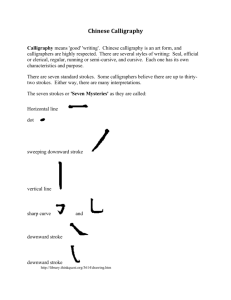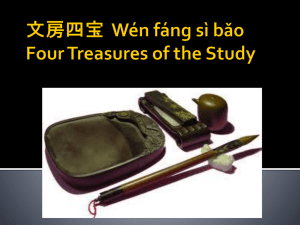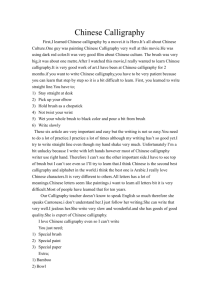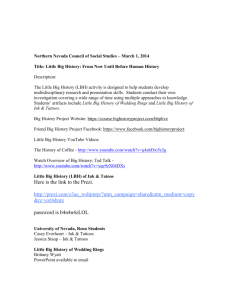The Art of Chinese Calligraphy
advertisement
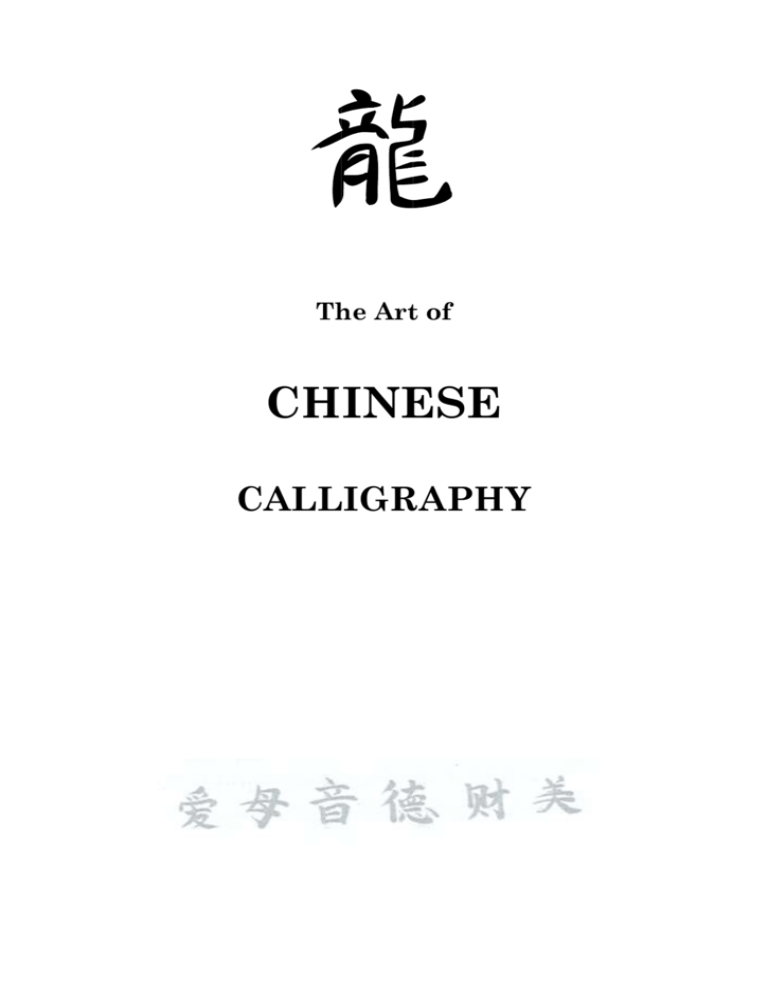
The Art of CHINESE CALLIGRAPHY Contents Introduction ………………………………………………… 3 In the Beginning …………………………………………… 4 The Tools …………………………………………………….. 5 Painting Position ………………………………………..… 8 Dancing on Paper ……………………………………….… 9 Brushstrokes ………………………………………………. 10 2 Introduction The art of Chinese calligraphy is almost as ancient as China itself. The characters can stand alone as a work of art, or appear as part of a painting. They are appreciated for the abstract beauty of their lines and shapes, as well as their meaning. The Chinese believe that hand writing reveals a person’s essence, or ch’i. Certain “imperfections,” such as running out of ink in the middle of a character, are desired expressions of the artist’s personality. So, just as two people may write the same English word in very different handwriting, the style of your Chinese calligraphy will be uniquely your own. You don’t have to read Chinese to become a calligrapher. With the Chinese calligraphy, you too can create beautiful and original works of art. It’s fun, creative, and your friends will be very impressed! 3 In the Beginning The word “calligraphy” is derived from a Greek word meaning beautiful writing. Yet, in contrast to calligraphy in Western culture, Chinese calligraphy is valued as “high art”. Just as there are masters of painting and sculpture, there are masters of calligraphy in China whose works are sold at high prices and exhibited in museums. Since Chinese calligraphy is also a very meditative practice, master calligraphers have been known to outlive their contemporaries. Calligraphy has always been important in Asia, as Chinese Imperial court executives and Korean officials were at one time chosen (at least in part) for their calligraphic talents. Even in today’s china, calligraphy is valued over machine printing and held in such esteem that paper containing words are often ritualistically destroyed in special pagodas. Calligraphy is more popular than ever in modern China and is practiced by people in all walks of life, amateur and professional. In the West, artists such as Picasso and Matisse were significantly influenced by Chinese calligraphy. Its popularity continues to rise in both America and Europe. Traditionally, Chinese calligraphy uses a brush and ink, while western calligraphy employs a pen and ink. Pens are being used more and more in China, but the pens used are rounded at the tip, unlike the flat-tipped pens used for western calligraphy. There are many different styles of Chinese calligraphy, from formal and straight to bold and carefree. Over the centuries, these styles have developed and changed so that characters with the same meaning may look very different from one another. 4 Colours are used in Chinese paintings, but characters are generally painted in black. The exception to that rule is a character carved into a seal, which is always applied with red ink. Many paintings will include one red character from a seal, which is called “adding the eye to the dragon.” In Chinese calligraphy it is usual to have: Brushes An ink stone Ink stick Mixing dish Small spoon Paper You’ll need a table with a flat surface, and cups with water. You my also find a paperweight helpful, as well as a brush rest, which you will use when you dry the brushes after your calligraphy sessions. Here are the basics you need to know about using the tools correctly. The Tools the brush The Chinese brush’s fine tip distinguishes it from the type of brush used for watercolour painting. This finer tip makes it possible to create lines of different widths and styles. As you become more advanced, you may want to experiment with different types of brushes. A soft brush is less elastic but allows for more creative expression, while a firmer brush creates stronger lines and is easier to control. If your new brush is covered with a cap, remove the cap and throw it away. Dip the brush in cool water and manipulate it with your fingers until it is pliable and ready for use. To enhance their versatility, many calligraphy brushes are purposely made with very little hair glued inside the handle. Therefore, it’s best to wash them with cool water, as hot water could melt the glue holding the hairs in place. 5 Make sure you remove all the ink after each use to prevent damage to the brush. Your brush should be dried by resting it on something that will allow the hairs to be suspended in air, preferably upside down with the brush pointed downward. You may choose to purchase a special brush rest made for this purpose. The moisture near the handle should be dried as quickly as possible to prevent hairs from loosening. No matter where you dry your brush, be sure not to lean it against anything, or it may stick. To maintain the longevity of your brush, always clean it thoroughly, dry it properly, and store it away from heat sources. the ink stone and the ink stick The ink is created by grinding an ink stick against an ink stone. This practice is considered a sacred meditative rite that prepares the calligrapher for the work to come. The ink stone is designed with a shallow well for water, and a flat surface for grinding the ink stick. Fill the well with about one teaspoonful of cool water. Never use warm water, as it could damage the stick. Dip your ink stick into the water and lightly grind it in a circular motion on the flat surface of the stone. Be sure to hold the stick vertically against the stone, as this angle prevents it from breaking. As the stick is ground into a powder, it mixes with the water to create the ink. Continue dipping the sick into the water as needed. When the ink reaches an oily consistency, it’s ready for use. The thickness of the ink will depend upon the amount of water on your ink stick, as well as how fine the grain of your ink stone. You will want to experiment with this until you have control over the result. Thick ink will appear glossy, dark and bold on the paper, while thin ink will appear translucent and airy. When you have prepared enough ink, transfer it to a plate or bowl. 6 If you mix too much ink, it will last for a few days. Brass boxes are traditionally used for storing mixed ink, but you may store it in a covered bowl. Bear in mind, however, that new ink will not mix well with old ink. Be sure to wash your ink stone thoroughly after each use with cold water. Never leave a wet ink stick on the stone, as they might bond to one another and become damaged. The stick is also quite brittle and fragile, so be careful not to drop it. Dry your ink stick suspended in air in the same way as your brush. While it may be tempting to skip the step of preparing the ink on the stone, bottled Chinese ink is not preferred for brush calligraphy, as only the ink stick can produce the desired shades of grey to black. the paper Paper used for Chinese calligraphy is usually called “rice paper” and is made from wood pulp and straw. A very absorbent type of paper, it comes in different weights, sizes and textures. Generally, the smoother the surface, the less ink it will absorb. This is preferable if a light and slick style is desired, but the more textured and absorbent papers are best for bold, dark characters. If the paper has one side that is more textured than the other, use the smoother side for painting. Chinese calligraphy may also be done on silk, but treating the silk for painting is a complicated procedure. Therefore, most calligraphers prefer paper. Different batches of the same paper can accept ink differently, and air moisture and temperature can make a difference as well. Therefore, it’s a good idea to test each type of paper to see how much ink you want on your brush and how much pressure to apply to obtain the desired result. To ensure the ink doesn’t soak through onto your table, keep newspaper or blotting paper underneath the absorbent rice paper while painting. You may choose to use a paperweight at times to hold the paper still, but it’s better to allow the paper to 7 be moved freely along the surface. With this method, you will never need to contort your body or stretch your arm too much. Painting Position For most characters, you will want to hold the brush in a vertical straight line above the paper, rather than at a slant. Use your thumb, index finger and middle finger, positioning them about halfway down the brush handle. Your ring finger can either support the handle or rest comfortably. Place your little finger wherever it feels most comfortable. But do not rest your hand on the paper. Because Westerners tend to hold a brush or pen at a slant toward the paper, holding the brush straight up may be awkward at first. With practice, you will find that this method allows for more control over the brushstrokes. Some brushstrokes will require the slanted position, however, in order to achieve the desired effect. Experiment with the position of your fingers on the brush, your distance from the page, and your hand’s distance from your body until you find the most comfortable position for you – one that allows for a free and fluid movement across the page. You want you arm to be free to move from the shoulder, so don’t follow the techniques so carefully that your body becomes rigid. How you hold the brush determines the variations you can achieve with your strokes. It’s best to maintain a firm but comfortable grasp. The upright position will produce a thinner line, while the slanted position can create a thicker line. The higher your fingers are on the handle, the weaker the stroke, and the lower your fingers are on the handle, the heavier the stroke. 8 Dancing on Paper Chinese characters are drawn in their own square, so it helps to practice in square grids. Each character has a certain number of strokes that should be drawn in a specific order. Traditionally, no strokes are added or deleted. Creativity is expressed in the fluidity and boldness of the writing. To be original, while following the set techniques and order of strokes, is the challenge. The most celebrated artists are known for the feeling of movement and rhythm in their characters and are said to be “dancing on paper.” Practice by tracing over the characters until you feel comfortable with the brush and ink. You may need to fill the brush a few times before you have the desired amount of ink through all the hairs. Scrape any dripping ink on the edge of the bowl. Even though rice paper is very absorbent, be careful not to use too much ink, or it may run. Obviously, a faster stroke will create a thinner line, and a slower stroke will create a thicker line. You will need to continuously reshape your brush to maintain its point. Control over the pressure of the brush on the paper is the most difficult part of Chinese calligraphy, so be careful not to damage the paper. With practice, you will muster the flow of brush movement and the correct pressure to create the desired thickness of line, with no paper damage or running ink. Dry brush stroke, sometimes called “flying white,” is a technique very different from western calligraphy. This is a stroke with sparse ink on the page. It’s generally recommended that you avoid too many dry brush strokes, but a few can be very expressive. If you wish to try this technique, wipe the brush clean before filling it with just a small amount of ink. If your best efforts are still not producing the results you want, experiment with the consistency of the ink, or try painting slower or faster. You could also change the direction of your brushstroke or your position next to the paper. 9 Chinese artists finish each work of calligraphy in a single session, as they believe the mood should be consistent throughout. Brushstrokes For the beginner, not being able to erase mistakes is the most frustrating aspect of Chinese calligraphy. You must instead start over until you get it right. Therefore, practice the basic brushstrokes until you gain confidence with each. If you accidentally leave a gap between strokes, don’t fill it in. If the gap doesn’t alter the character too much, you may like the effect. If not, start the character over, as fluidity is of utmost importance. Are you ready? It’s time now to practice the basic strokes. For the horizontal stroke, touch the brush onto the paper with a slight upward movement, then come back down to sweep right, bearing down on the brush with heavier pressure. As you reach the end of the stroke, lighten the pressure, bearing down with heavier pressure just at the end, completing with a downward flick. For the vertical stroke, begin by bending the tip of the brush down for the hook at the top. Then bring the brush down steadily, creating a point at the bottom of the line. Note that there is no hook at the end of the stroke. The curved “left leg” stroke is often thought to resemble an elephant tusk. Begin at the top, bending the tip of the brush for the hook, and then sweep downward to the left in a slight curve, ending in a point. 10 For the “right leg” stroke, begin at the top of the stroke, and sweep downward to the right, again ending in a point. The next stroke is a variation of the horizontal stroke, also written from left to right, except with a rightward slant. The dots are drawn with slight variations depending upon the character. For the basic dot, start with a point and brush downward, slightly slanted to the right. A variation is to add a pointed left hook to the basic dot. The next stroke is similar to the vertical stroke, except with a pointed hook to the left at its bottom. The bending stroke is drawn in two variations, either with a horizontal stroke followed by a vertical, or a vertical followed by a horizontal. After you have practiced the strokes, it is important to learn the stroke order of the character you wish to create, so that you may flow through the writing without stopping and starting. In general, the strokes are drawn from top to bottom and left to right, and stroke order is strictly adhered to. To create the most harmonious calligraphy, however, try to see each character as a whole rather than the sum of the parts. When you’re ready, experiment with expressing your mood through your strokes. How wet do you want the ink? How thick do you like the strokes? How free or how uniform do you prefer the characters? Many Chinese characters are a combination of two other characters. A character will be centred in a grid when alone, but may be drawn with shorter strokes and placed off 11 centre when combined with another character. In this case, beauty takes precedence over precision. After you have mastered the various strokes, practice the characters below. Be patient with yourself, enjoy practicing. Soon you will be proud to share your beautiful works of art with family and friends! The following shows you how to create four popular characters. Just make the strokes in the proper order. 12

